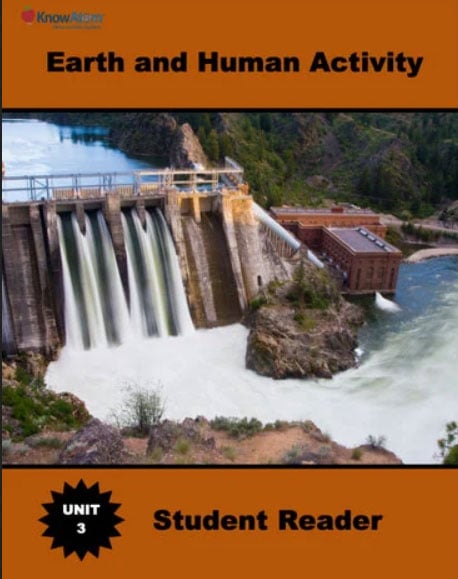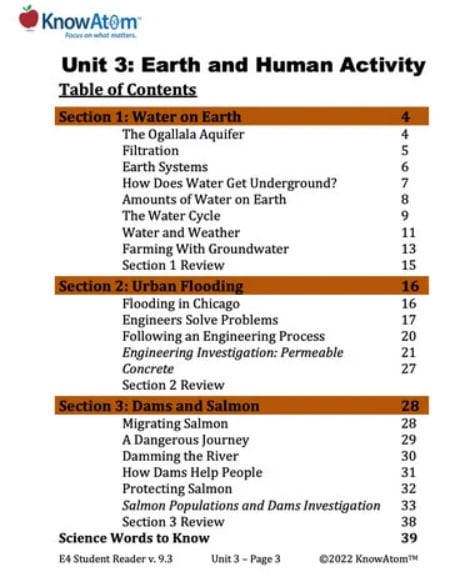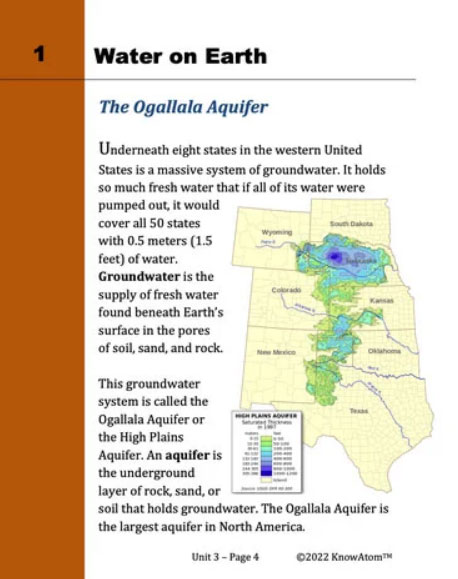Once students understand how the hydrosphere and the geosphere interact to store groundwater, they use that scientific knowledge in this lesson to engineer a permeable concrete material that solves the problem of flooding in urban environments.
In this unit, students explore the science phenomena of Earth systems by studying aquifers, comparing the ability of different Earth materials to hold water. In this lesson, they build on that knowledge to engineer permeable pavement that can solve the problems of urban flooding and water pollution. This page showcases key components of this lesson.
Science background gives teachers more detailed information on the phenomena students study in this unit. Below is an excerpt from the science background for this lesson on engineering permeable concrete to solve the problem of urban flooding.
When heavy precipitation occurs, it can cause flooding. Flooding is an event that occurs when water overflows onto land that is normally dry. The surface on which the rain falls plays a role in how much flooding occurs. When rain falls on traditional concrete or asphalt, it just runs off because these materials are impermeable.
In urban areas such as Chicago, Illinois, stormwater runoff can also become polluted. Water pollution is the contamination of natural water bodies by substances that harm organisms and the environment, and it can be natural or caused by humans. Urban water can become polluted in several ways. Surface water can become polluted from various sources, including oil, fertilizer, pesticides, and animal waste.
Another problem with impermeable pavement is that less water can absorb into the ground. As a result, aquifers do not get replenished.
Engineers have turned to permeable pavement as a solution to urban flooding and water pollution. Engineers are people who use scientific knowledge and mathematics to solve a problem by creating new technologies. Engineers often follow a process of eight steps to solve problems by creating new technologies.
The engineering process always begins with a problem. In Chicago, the problem was flooding that occurred when heavy rains fell on impermeable materials in the city. That flooding turned into stormwater runoff that was often polluted. When engineers are defining a problem, they include the criteria. The criteria are the needs the solution must meet. They also include the constraints. Constraints are ways the solution is limited. Cost and materials are two common engineering constraints.
Once they have identified the problem, engineers need to research the problem to find out what is known about the problem. For example, engineers need to know that permeable materials allow water to flow through them easily. They also need to know that some materials filter water better than other materials.
After engineers have researched their problem, they survey the available materials. This survey includes a sketch of the material, as well as how much of the material they have available and the properties of that material. For example, the Chicago engineers needed to think about the porosity and permeability of the materials they were planning to use.
Engineers then come up with possible solutions for how the problem can be solved with the available materials. Possible solutions to flooding include designing permeable materials that can be used instead of traditional, impermeable concrete.
The next step is to diagram and build a prototype. A prototype is a scaled-down first draft of a technology. Once built, engineers test the prototype. They use the tests to gather data, which are measurements and observations that capture how well the prototype solves the problem during testing. Engineers who want to know how well their permeable material reduces flooding test it to see how much water it absorbs.
Finally, engineers use their data to decide whether to refine or replicate. The data tell engineers whether their prototype technology solved the problem.
Once students understand how the hydrosphere and the geosphere interact to store groundwater, they use that scientific knowledge in this lesson to engineer a permeable concrete material that solves the problem of flooding in urban environments.

Prepared hands-on materials, full year grade-specific curriculum, and personalized live professional development designed to support mastery of current state science standards.
Climate: the average weather over a span of 30 years
Engineer: a person who uses scientific knowledge and mathematics to solve a problem by creating new technologies
Flooding: an event that occurs when water overflows onto land that is normally dry groundwater – the supply of fresh water found beneath Earth’s surface in the pores of soil, sand, and rock
Permeability: the ease with which substances such as water move through a material
Porosity: the number of spaces between particles in a substance
Prototype: a scaled-down first draft of a technology
System: a set of connected, interacting parts that form a more complex whole
Weather: the conditions of the atmosphere (temperature, humidity, wind speed, air pressure, and precipitation) in a particular place at a particular time
Flooding in Chicago
The city of Chicago, Illinois, has 3,057 kilometers (1,900 miles) of public alleys. Years ago, city planners decided to pave the alleys with regular concrete or asphalt.
However, concrete and asphalt are both impermeable. This means that water cannot absorb into them. Instead, the water remains on the surface.
This creates several challenges. During heavy rains, flooding can occur. Flooding happens when water overflows onto land that is normally dry. In urban areas such as Chicago, the water also often becomes polluted. Finally, less water can absorb into the ground. As a result, aquifers cannot be replenished.
Engineers Solve Problems
Engineers in Chicago decided to come up with solutions to reduce the amount of flooding during a big storm. Engineering is different from science, although science and engineering are connected. Scientists use experiments to gain knowledge. Engineers use that scientific knowledge and mathematics to solve a problem by creating new technologies.
Similar to how scientists follow a scientific process to answer a question, engineers also follow a process. Engineers often follow eight steps to guide them as they create new technologies to solve problems.
The engineering process begins with a problem. In Chicago, the problem was flooding that occurred when heavy rains fell on impermeable surfaces in the city. That flooding turned into stormwater runoff that was often polluted. When engineers are defining a problem, they include the criteria. The criteria are the needs the solution must meet. They also include the constraints. Constraints are ways the solution is limited.
Once they have identified the problem, engineers need to research the problem to find out what is known about the problem. For example, engineers need to know that permeable materials allow water to flow through them easily. They also need to know that some materials filter water better than other materials.
After engineers have researched their problem, they survey the available materials. This survey includes a sketch of the material, as well as how much of the material they have available and the properties of that material.
For example, the Chicago engineers needed to think about the porosity and permeability of the materials they were planning to use.
Engineers then come up with possible solutions for how the problem can be solved with the available materials. Possible solutions to flooding include designing permeable materials that can be used instead of impermeable concrete.



For the hands-on activity in this lesson, students use the engineering process to design a permeable concrete material that solves the problem of flooding in urban environments. Students collect and analyze data on the filtration speed of their prototype, looking for patterns that indicate how well the composition of their permeable concrete solved the problem.
KnowAtom incorporates formative and summative assessments designed to make students thinking visible for deeper student-centered learning.

Standards citation: NGSS Lead States. 2013. Next Generation Science Standards: For States, By States. Washington, DC: The National Academies Press. Neither WestEd nor the lead states and partners that developed the Next Generation Science Standards were involved in the production of this product, and do not endorse it.